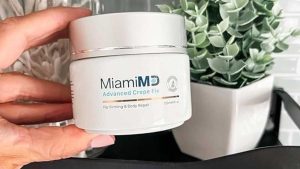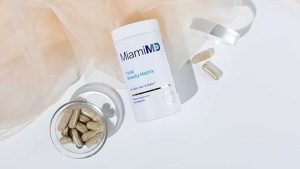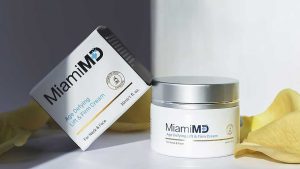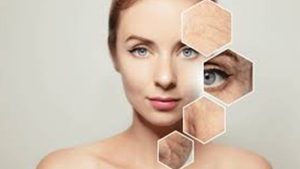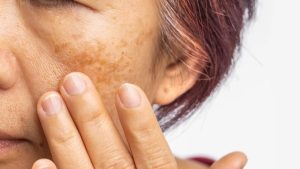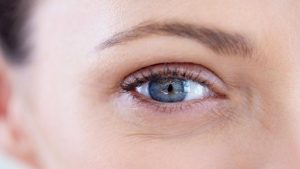Identifying Crepey Skin And How To Treat It

Have you ever heard the term “crepey skin” before? While not an official dermatological term, it accurately describes the appearance of a specific skin complaint many people notice during the aging process.
Crepey skin can make people feel less confident and less attractive, which is why we wanted to target it with the functional beauty products we create at Miami MD.
Let’s learn more about how you can identify the signs that you may be dealing with crepey skin, and how you can treat it using a few, simple changes to your skin care routine.
What Does Crepey Skin Look Like?
If you’re trying to figure out whether or not you’re dealing with crepey skin, here are a few details that best describe the appearance of this type of skin:
- Thin
- Finely wrinkled
- Saggy
- Loose
- Fragile
Essentially, crepey skin is similar in appearance and feel to the tissue paper that you use in gift bags.
While it may get lumped together with the general category of “aging skin,” crepey skin presents its own, unique issues due to how thin and fragile it can be.
Treating it also requires specific, targeted skin care products instead of a general “aging” approach.
Crepey skin is more likely to happen in areas of the face that are already known for being thin, especially the under-eye area. It can also appear on other parts of the body, specifically the upper, inner arms.
What Causes Crepey Skin?
It’s difficult to really narrow crepey skin down to one specific cause, as it’s generally a symptom of a number of different things that can happen to the body as we age. However, the appearance of crepey skin can also be exacerbated by a few environmental factors.
While we ultimately can’t stop the aging process, awareness of what we can do to make sure we’re taking the best care of our skin possible can help hold it at bay for as long as possible.
Here are a few of the more commonly accepted triggers of the development of crepey skin.
Sun damage (chronic UV radiation exposure)
Sun overexposure is one of the main factors in a lot of different health issues and cosmetic concerns.
According to the Environmental Protection Agency (EPA), sun overexposure has been linked to different types of skin cancer, cataracts/eye damage, immune system suppression, and premature aging (as well as other skin issues like actinic keratosis).
In addition to crepey skin, sun damage can also lead to thickened skin that looks leathery and wrinkled. It’s thought that 90% of the visible skin changes that people attribute to “normal” aging are actually the result of chronic sun overexposure.
Unfortunately, it can take years for the results to be seen, so many people aren’t aware of the damage until it is too late.
Aging (mostly related to the loss of collagen and elastin in the skin)
Although sun exposure can contribute to the speed that the collagen and elastin break down in the skin, this will inevitably happen at some point in life regardless. If you’re familiar with skin care and the anatomy of the face, you likely already know how important collagen is for the face.
What fewer people are familiar with, though, is how soon the collagen production begins to drop off. This can start slowly in our mid-20s and, when we are finally finished with menopause, we’ve lost 30% of the collagen we had when we started it.
With less collagen and elastin, our skin isn’t as plump and firm and those fine lines and wrinkles start to show.
Chronic dehydration
Dehydration can impact the body both inside and out. Our skin cells need water to revitalize and renew themselves, a process that happens every 28 days or so.
Considering that the body contains around 60% water, making sure to stay hydrated is essential to keeping the body functioning at its most optimal level.
When you’re dehydrated, your body can’t rid itself of toxins and it pulls all the water it can from the skin in order to keep working…leading to thin, crepey skin.
Chronic dehydration can also lead to issues with mood, your kidneys, your GI system, etc.
Excessive or rapid weight loss
The skin can be incredibly resilient but rapid weight loss combined with the gradual loss of collagen and elastin in the skin can lead to that telltale loose, saggy skin. Losing weight slowly gives the skin more time to adjust, which is why it happens less in gradual weight loss.
Treatment Options For Crepey Skin
Crepey skin treatments are most likely to be effective if you start them as soon as you first notice issues. The way you treat it also depends on how aggressive you want to be, and how advanced the issue is.
Treatment with skin care products is one way to start working on crepey skin without having to go through expensive, sometimes painful procedures. In most cases, these products come in serum form.
Take Miami MD’s Instant Wrinkle Eraser, for example.
This product focuses on the signs of crepey skin and other age related concerns by using targeted ingredients. Matrixyl synthe-6 helps boost collagen production, while acetyl hexapeptide 30 works similar to topical Botox to help relax the nerves responsible for the repeated muscle movements that lead to fine lines and wrinkles.
Just apply directly to the face after cleansing and before a moisturizer, and enjoy the results in next to no time.
Retinols can also help but, to be the most effective, they do require a trip to the dermatologist. They work by encouraging the skin’s renewal process to speed up and act as an exfoliant, helping to clear out the old, dead skin cells that can also make the skin look dull.
Retinols should be used with caution, though, as they can dehydrate the skin and make crepey skin worse if not used with the right moisturizer. It requires a delicate balance that can be challenging to achieve without professional guidance.
There are other dermatological procedures that people may consider if they’re ok with the cost associated with them. Cryolipolysis (known as CoolSculpting), ultrasound treatment (the Ulthera procedure), and fractional laser treatment (using a Fraxel machine) are all options, as well as fillers and Botox.
However, these procedures do involve going to a licensed, medical professional and can involve some downtime as the skin heals.
Prevention Techniques For Crepey Skin
Instead of treating the signs of crepey skin, why not prevent them in the first place? The prevention techniques suggested to help this specific issue are also good for your health overall, so there really is nothing to lose by making a few, easy lifestyle changes.
First and foremost, try to reduce your direct sun exposure as much as possible. That means avoiding the sun as much as you can, and wearing a high quality sunscreen every time you leave the house.
Many skin care products and cosmetics now include sun protection in them, so it’s easier to do than you think. Make sure the SPF is at least 30, and that it provides broad spectrum protection against both UVA and UVB rays, while also being formulated to be water resistant.
Focusing on your hydration level is also essential, both inside and out. Make sure to drink the recommended amount of water (at least 2 liters a day) to keep your body hydrated from the inside, while also selecting a quality moisturizer to specifically take care of the skin on your face.
Hyaluronic acid is a great ingredient to look for, as is anything that is non-comedogenic — meaning it doesn’t clog your pores. This is an essential part of any skin care routine, and especially important to people seeking to prevent crepey skin before it starts.
There is also some evidence that antioxidants may help to fight off the signs of aging, both internally and externally.
Eating fresh fruits and vegetables, especially those known for their high antioxidant content, like blueberries, kale, and grapes can help inside the body, and incorporating skin care products with vitamin C (also labeled as ascorbic acid or l-ascorbic acid) can protect and treat the skin from the outside.
Plus, antioxidants are just good for your body overall, and create a healthy, radiant glow.
In Summary
Aging is a normal part of life, but that doesn’t mean that you have to put up with crepey skin.
Preventing premature aging in the first place, by developing a supportive skin care routine, avoiding sun overexposure, and staying hydrated, and treating it with the appropriate skin care products when or if it occurs (like the functional beauty products we offer at Miami MD) can make a major difference in both how you look and how you feel about yourself.
At the end of the day, being confident in yourself is one of the best things that you can do for yourself.
Sources:
Health Effects of Overexposure to the Sun | EPA
